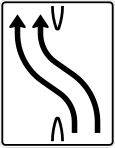Transition (job security)

|

|
|
Different signs of a transition, only the right plate has announcing to oncoming traffic towards |
|
In road construction, a transition describes the transfer of traffic to the opposite lane . It is usually set up in front of a job on a motorway or expressway and thus enables, for example, 4 + 0 traffic routing . The so-called median crossing (MÜF for short) is used for the transition. This is a section paved with concrete or asphalt between the two directional lanes. At the end of the job, a return line is set up and the traffic is directed back onto the original lane.
To set up the transition, the protective devices , such as crash barriers or concrete protective walls , are dismantled at so-called predetermined breaking points and then traffic safety, consisting of warning beacons with warning lights and lane markings, is set up. In order to make road users aware of this danger area at an early stage and thus to avoid accidents, a speed funnel must be installed in front of such workplaces, at least on motorways , which gradually brings the maximum speed down to the speed that is unusual for motorways. In addition, warning devices must be set up at a sufficient distance. These must be provided with retroreflective protective foils so that they can be seen clearly at night and in adverse weather conditions.
The legal basis is Section 42 of the Road Traffic Act
Operating modes
- Regular transition of the entire directional lane to the opposite lane , from which it is to be separated with a lane divider , but occasionally with a limited width of the left lane with no overtaking for heavy traffic .
- Transfer of only one lane to a one-way lane, the width of the lane can also be limited here, i.e. it can be blocked for certain types of vehicles.
- There is no transition, it is just a pivoting lane . It can be pivoted to the right (using the hard shoulder) or to the left, as long as the work area is spatially narrower.
Connection points
Departure from junctions in mode 1 must also be guaranteed by crossing the median, an acceleration lane cannot be offered. Entrances from junction points must be made with a stop Give way to be secured. Crossing the median must be secured in operating mode 1. The through traffic must use the zip method. In operating mode 2, access to the junction is to be guaranteed by means of a lane divider on the lane that does not cross the median crossing. In the area of the junction, the speed must be reduced significantly to a level that is unusual for a motorway. In operating mode 3, the pivoting can even lead to permanent use of the hard shoulder by trucks and buses ; a threading lane is not required here; it can be present when pivoting to the left.
Roads that are used in two-way traffic must be separated from the traffic on the directional lane by means of concrete protective walls.
Norms and standards
- Germany
- Austria
- RVS 05.05.40 ff. - Construction site protection
- Switzerland
- SN 640 885c - Signalization of construction sites on motorways and motorways
See also
- Junction (motorway) #DDI / DCD (junction with transfer to the feeder)
